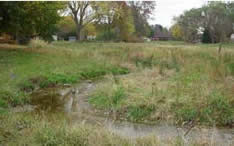6.7.4 Floodplain restoration

Floodplain restoration tries to mimic the interaction of groundwater, stream base flow, and root systems -- key components of a stream corrdor under pre-settlement (pre-1600s) conditions. Under pre-settlement conditions, typically the roots of the riparian vegetation on the floodplain were directly linked to teh base flow elevation of the stream. Groundwater frequently interacted with the root zones and the stream's base flow. Where the groundwater was lower than the stream's base flow, the gravel-lined streams and permeable floodplains frequently reduced surface flows through infiltration. The interaction among the stream's base flow, groundwater, permeable floodplain soils, and riparian root zones provides multiple benefits, including the filtering of sediments and nutrients through retention of frequent high flows onto the floodplain, removal of nitrates from groundwater, reduction of peak flow rates, groundwater recharge/infiltration, and increase of storage and reduction of flood elevations during high flows. As a result of historical and recent human impacts, many stream networks have little interaction among the groundwater, stream base flow, and teh root systems of floodplain vegetation. Frequently, recently deposited floodplain soils are cohesive, separating the root zones from base flow and allowing only minimal infiltration from the surface flow through the porous pre-settlement soils and gravels. Floodplain restoration as a BMP should be considered where there is minimal interaction among the key components. Other benefits of this BMP include thermal cooling of the stream base-flow,improved benthic community species diversity and habitat, re-establishment and significant increases of wetland areas and native plant species on the floodplain, reduction of invasive plant species, and increased acquatic habitat and riparian areas.
Structural BMPs
- Volume/Peak Rate Reduction by Infiltration BMPs
- 6.4.1 Pervious pavement with infiltration bed
- 6.4.2 Infiltration Basin
- 6.4.3 Subsurface Infiltration bed
- 6.4.4 Infiltration trench
- 6.4.5 Rain Garden/bioretention
- 6.4.6 Dry well/seepage pit
- 6.4.7 Constructed filter
- 6.4.8 Vegetated swale
- 6.4.9 Vegetated Filter strip
- 6.4.10 Infiltration berm & retentive grading
- Volume Peak Rate Reduction BMPs
- Runoff Quality/Peak Rate BMPs
- Restoration BMPs
- Other BMPs and related Structural Measures


